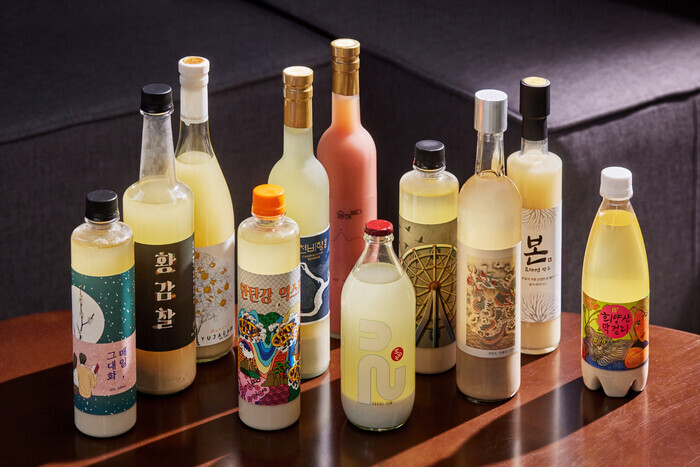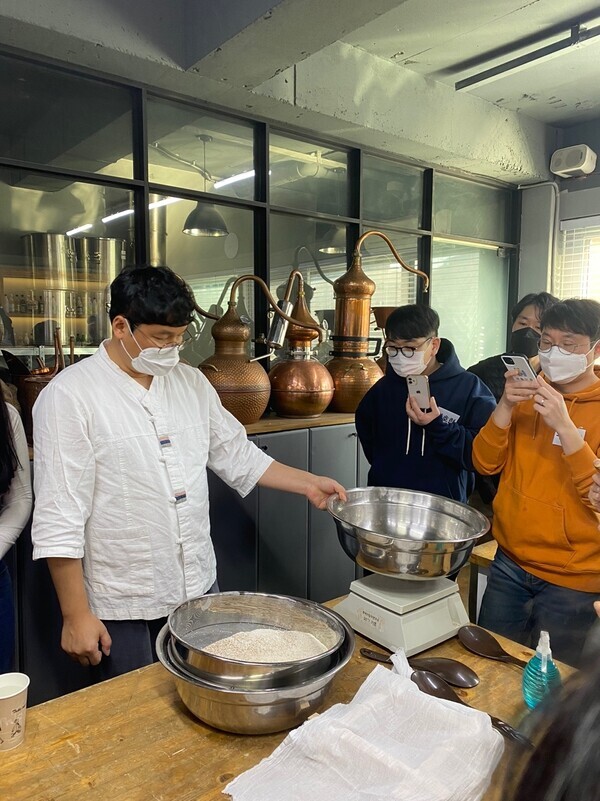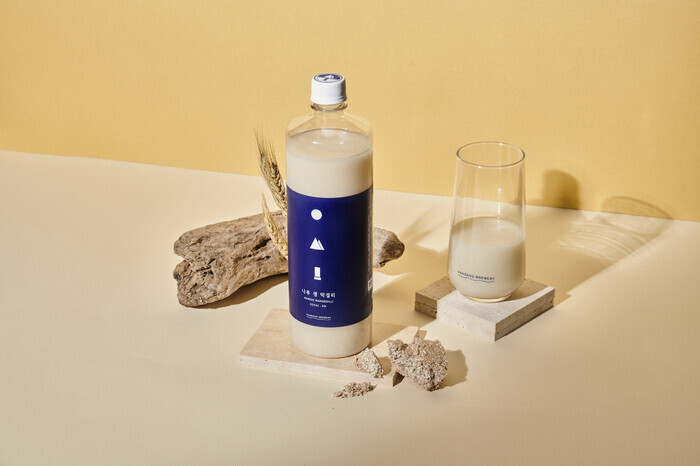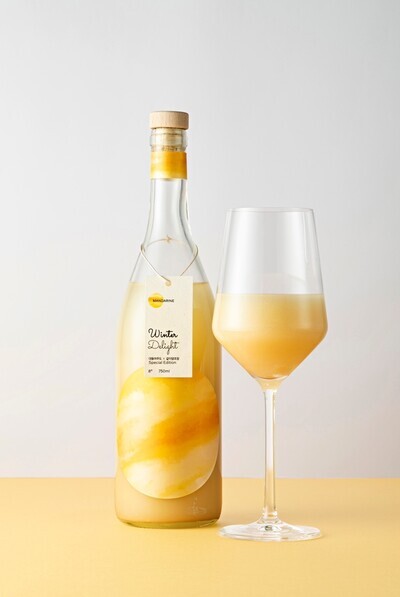hankyoreh
Links to other country sites 다른 나라 사이트 링크
Makgeolli makes a comeback as Korea’s trendiest ancient drink

“This is the era of makgeolli.”
Makgeolli is finally getting its glow-up. The rice beer used to be the go-to drink of middle-aged Korean men. But today, it’s a must-have beverage for younger generations.
For a while in the mid- and late 2000s, the makgeolli wave that began in Japan rolled over Korea, too. But that fad was over almost as soon as it had begun. Brewers hadn’t developed a wide enough range of products to lure customers to the market.
It was fortunate that regional breweries had been brought back from the brink of bankruptcy, but makgeolli wasn’t very popular in the alcoholic beverage market.
A few years ago, things started to change. Young entrepreneurs who had leapt into the makgeolli market parted ways with the monotonous brews that were typified by Jangsu Makgeolli and started releasing more diverse, and more deluxe, products.
It’s not for nothing that people are describing makgeolli as the drink preferred by the younger crowd. Even the packaging is enough to make you wonder if you’re actually looking at a bottle of makgeolli.
Whence comes makgeolli’s new potential as an alcoholic beverage? And what makes it so appealing?

Bae Su-hyeon, a 29-year-old who works for an apparel company, says her current hobby is collecting makgeolli. She’s too picky for the typical makgeolli sold on supermarket shelves — she craves a sip of premium makgeolli spiced up with a smorgasbord of additives and limited edition makgeolli that requires a reservation on social media.
“In the past, there wasn’t a wide range of flavors, and people saw this as a drink for older men. But more recently, the packaging has gotten more attractive, and flavors have diversified as well. That gives us more options. I see it as a good choice of drinks, partly because it doesn’t give me a headache the next day,” Bae said.
Industry figures show that makgeolli output is gradually increasing. According to the Korean Home-Brew Institute, 379,992 kiloliters (kL) of makgeolli were produced in 2020. That was 9,400 kL more than in 2019 (370,500 kL), reversing a decline that had continued since production peaked at 458,198 kL in 2011. Not a huge change, but notable in that it suggests a shift in direction.
For younger people craving new experiences, makgeolli is not merely a drink — it has become a cultural phenomenon. That phenomenon has been reinforced by TV shows about Korean alcohol such as “Paik’s Spirit” and “Koreans’ Bar Table.”

An internet search for such phrases as “how to make makgeolli,” “how to drink makgeolli,” or “makgeolli taste test” will return thousands of hits.
“Makgeolli culture for the young generation involves the fandom created as people make posts on social media about buying drinks from their favorite brewery,” explained Kim Da-seul, a sommelier of traditional alcohol. She suggested that this phenomenon is coalescing around makgeolli.
Furthermore, people who used to simply drink makgeolli are starting to evolve into aficionados of the stuff.
The Korean Home-Brew Institute has seen a surge of interest in its classes on traditional alcohol, which fill up more than a year in advance. Right now, there are more than 300 people on the waiting list, showing that people aren’t satisfied with merely drinking makgeolli, but want to make it themselves.
Most of the institute’s students are young people.
“Right now, our students are the youngest they’ve been since the institute was established in 2010. In the past, most of our students were aged 40 and above, but more recently, people in their 20s and 30s make up the majority,” said Ryu In-su, director of the institute.
An influx of passionate and studious people in that age group has naturally made the makgeolli industry younger.
“The industry becoming younger means a stronger foundation is being built on which we can count on even more steady growth,” Ryu added.

Makgeolli drinkers aren’t the only ones getting younger — the brewers are, too. One example is Hangang Brewery, which is regarded as a hip makgeolli and has a well-known advertising campaign on Naver, one of Korea’s leading search engines.
Koh Sung-yong, the brewery’s CEO, was inspired to enter the industry by the thought that even a traditional alcohol like makgeolli could be seen as hip and youthful.
“My goal was to show how makgeolli culture can be hip to the younger generation,” Koh said.
Hangang Brewery has been finding various ways to communicate with the younger generation while developing Pyomun Makgeolli (made with the Gompyo brand of flour from Daehan Flour) and GQ Makgeolli (a collaboration with men’s fashion magazine GQ), in addition to its signature Naroo Makgeolli.
The company’s seven brewers have an average age of 30, showing that they’re primed to understand the mentality of young people today.
The success of Hangang Brewery has inspired more young people to open small-scale breweries. Young entrepreneurs are particularly drawn to the fact that traditional alcohol can be sold over the internet — which is not true of other kinds of alcohol.
“Another reason is that [the makgeolli industry] doesn’t have big up-front costs, which makes things easier for young people who have less capital to work with,” Ryu said.
Removing legal obstacles to brewing alcohol on a small scale has lowered the entry barrier for brewery start-ups, he said.
Makgeolli consumption trends also reflect this youthful shift, and the number-one forum for marketing makgeolli is social media.
Guruma Brewery, based in Seoul’s Mapo District, sold out of Yugaja as soon as it launched the makgeolli in September 2021 despite the steep price of 30,000 won — roughly US$24.
That brew had a limited run of 200 bottles and somewhat inconveniently could only be purchased through social media. But that turned out to be a unique marketing strategy and made Yugaja the hottest makgeolli on social media last year.
So Ji-seop, the brewer, said that most customers are women in their twenties or thirties and that 80% of customers became repeat buyers.
Social media is crucial both as a medium of communication and as a means of doing business. It’s also the meeting point of producers and consumers.
“I sensed that the makgeolli consumer base was broadening while reading feedback from younger customers who were posting photos they had taken with makgeolli in sophisticated interiors,” said Kang Hyeok, a manager at traditional alcohol producer Soolawon.
“One of the characteristics of the younger generation is that they like communication. Young people who are starting breweries today are very adept at communication. They use social media proactively to meet directly with consumers. They’ve played a big role in bringing younger people into the makgeolli market,” said Kim Da-seul, the sommelier.

Younger people who are flocking to makgeolli no longer see it as a cheap form of booze.
Summer Delight and Winter Delight, two kinds of makgeolli made by Together Brewery, fly off shelves despite retailing for 80,000-90,000 won, with a wholesale price of 45,000 won.
“Winter Delight is mainly purchased by women in their 30s, and there was a buzz when people started posting it on social media with the hashtag ‘the Dior of Makgeolli.’ Consumers in their 20s and 30s are surprisingly ready to open their wallets. They don’t bat an eye about spending 20,000 won or more on a bottle of makgeolli. They don’t have the stereotype that makgeolli is cheap booze,” said Lee Ji-min, CEO of Daedong Yeojudo.
Another factor behind makgeolli’s growing popularity is that an increasing number of traditional bars carry various kinds of makgeolli. Suave traditional establishments targeting a younger crowd have multiplied over the past few years, and interest in premium makgeolli has shot up along with it.
It’s no coincidence that traditional bars have returned from a hiatus to set up shop in some of Seoul’s most happening nightlife spots, such as Gangnam, Mapo, Seongsu and Sinchon.
Dedicated makgeolli bars that carry 20-30 types of makgeolli are also starting to open. One appealing aspect for the entrepreneur is that makgeolli has a higher margin than typical beer or soju, a distilled spirit popular in Korea.
“The main buyer of Sula Handmade Makgeolli, our premium product, is a bar in one of Seoul’s hottest neighborhoods,” Kang said.
By Baik Moon-young, guest reporter
Please direct questions or comments to [english@hani.co.kr]

Editorial・opinion
![[Column] Life on our Trisolaris [Column] Life on our Trisolaris](https://flexible.img.hani.co.kr/flexible/normal/500/300/imgdb/original/2024/0505/4817148682278544.jpg) [Column] Life on our Trisolaris
[Column] Life on our Trisolaris![[Editorial] Penalties for airing allegations against Korea’s first lady endanger free press [Editorial] Penalties for airing allegations against Korea’s first lady endanger free press](https://flexible.img.hani.co.kr/flexible/normal/500/300/imgdb/original/2024/0502/1817146398095106.jpg) [Editorial] Penalties for airing allegations against Korea’s first lady endanger free press
[Editorial] Penalties for airing allegations against Korea’s first lady endanger free press- [Editorial] Yoon must halt procurement of SM-3 interceptor missiles
- [Guest essay] Maybe Korea’s rapid population decline is an opportunity, not a crisis
- [Column] Can Yoon steer diplomacy with Russia, China back on track?
- [Column] Season 2 of special prosecutor probe may be coming to Korea soon
- [Column] Park Geun-hye déjà vu in Yoon Suk-yeol
- [Editorial] New weight of N. Korea’s nuclear threats makes dialogue all the more urgent
- [Guest essay] The real reason Korea’s new right wants to dub Rhee a founding father
- [Column] ‘Choson’: Is it time we start referring to N. Korea in its own terms?
Most viewed articles
- 1New sex-ed guidelines forbid teaching about homosexuality
- 2OECD upgrades Korea’s growth forecast from 2.2% to 2.6%
- 3[Column] Life on our Trisolaris
- 460% of young Koreans see no need to have kids after marriage
- 5Months and months of overdue wages are pushing migrant workers in Korea into debt
- 6Inside the law for a special counsel probe over a Korean Marine’s death
- 7Korean government’s compromise plan for medical reform swiftly rejected by doctors
- 8[Guest essay] Maybe Korea’s rapid population decline is an opportunity, not a crisis
- 9Trump asks why US would defend Korea, hints at hiking Seoul’s defense cost burden
- 10Two lung cancer deaths at Samsung Electronics deemed occupational in nature